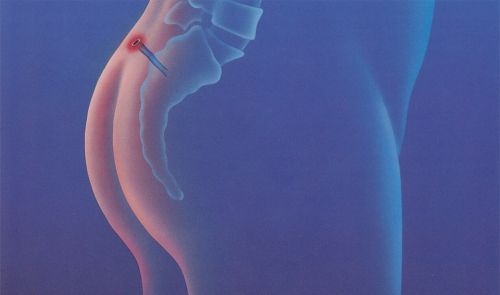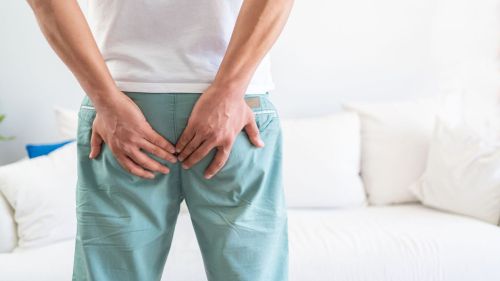An ailment caused by hair entering under the skin and creating an infection in the body. Ingrown hair usually occurs in the tailbone area. Hairs accumulate under the skin, causing inflamed swellings and abscesses. As the infection progresses, severe pain and discomfort may occur. If left untreated, surgical intervention may be necessary. Cleanliness and hygiene are important in prevention.
Ingrown Hair Symptoms
 Ingrown hair usually causes pain in the tailbone area. Redness, swelling, and tenderness can be seen in the affected area. Small holes or abscesses may form on the skin. These openings can discharge foul-smelling yellow or bloody fluid. In inflamed cases, fever and a general feeling of malaise may occur. The skin in the area may become irritated. As the symptoms of ingrown hair progress, discomfort can increase, making early intervention important.
Ingrown hair usually causes pain in the tailbone area. Redness, swelling, and tenderness can be seen in the affected area. Small holes or abscesses may form on the skin. These openings can discharge foul-smelling yellow or bloody fluid. In inflamed cases, fever and a general feeling of malaise may occur. The skin in the area may become irritated. As the symptoms of ingrown hair progress, discomfort can increase, making early intervention important.
Causes of Ingrown Hair
 Hairs shed from the body enter the skin in moist and enclosed areas like the tailbone, causing infection. This situation leads to ingrown hair. Sitting for long periods or staying immobile creates pressure in the tailbone and increases the likelihood of hairs entering the skin. Some people's skin structure and hair growth rate make them more prone to this condition. Individuals with densely hairy skin may experience it more frequently. Poor hygiene conditions cause dirt and hairs to accumulate on the skin and enter the skin, leading to infection. These factors are the main causes of ingrown hair. If left untreated, the infection can progress and lead to more serious problems.
Hairs shed from the body enter the skin in moist and enclosed areas like the tailbone, causing infection. This situation leads to ingrown hair. Sitting for long periods or staying immobile creates pressure in the tailbone and increases the likelihood of hairs entering the skin. Some people's skin structure and hair growth rate make them more prone to this condition. Individuals with densely hairy skin may experience it more frequently. Poor hygiene conditions cause dirt and hairs to accumulate on the skin and enter the skin, leading to infection. These factors are the main causes of ingrown hair. If left untreated, the infection can progress and lead to more serious problems.
Diagnosis of Ingrown Hair
 The doctor carefully examines the patient's tailbone area. Ingrown hair may present with swelling, redness, tenderness, and discharge in the affected area. Additionally, if there is an infection, inflammation and pain may be observed. The doctor gathers information about the patient's previous complaints and symptoms. The patient's risk factors, such as continuous sitting or prolonged friction, are queried. Generally, laboratory tests are not needed for diagnosis. However, if there is an infection, blood tests may be done, and a culture may be taken from the discharge. In rare cases, imaging methods like ultrasound or MRI may be used to see the sinus channels and the spread of the infection. The diagnosis of ingrown hair is easily made through physical examination and evaluation of symptoms.
The doctor carefully examines the patient's tailbone area. Ingrown hair may present with swelling, redness, tenderness, and discharge in the affected area. Additionally, if there is an infection, inflammation and pain may be observed. The doctor gathers information about the patient's previous complaints and symptoms. The patient's risk factors, such as continuous sitting or prolonged friction, are queried. Generally, laboratory tests are not needed for diagnosis. However, if there is an infection, blood tests may be done, and a culture may be taken from the discharge. In rare cases, imaging methods like ultrasound or MRI may be used to see the sinus channels and the spread of the infection. The diagnosis of ingrown hair is easily made through physical examination and evaluation of symptoms.
Treatment of Ingrown Hair
If there are signs of infection, antibiotics may be administered. This treatment alleviates the infection but usually does not completely solve the problem. Under local anesthesia, the hair and abscesses in the infected area can be cleaned. This procedure is suitable for small and medium-sized cases. For advanced cases, surgical treatment is recommended. Using different surgical techniques, the ingrown hair area is removed and cleaned. Post-surgery, regular cleaning and care of the area are important. In some cases, laser treatment may be used to destroy the hair follicles and prevent recurrence. Paying attention to the hygiene of the area after treatment is important to prevent recurrence. Drinking plenty of water, maintaining weight control, and following hygiene rules are also recommended.


